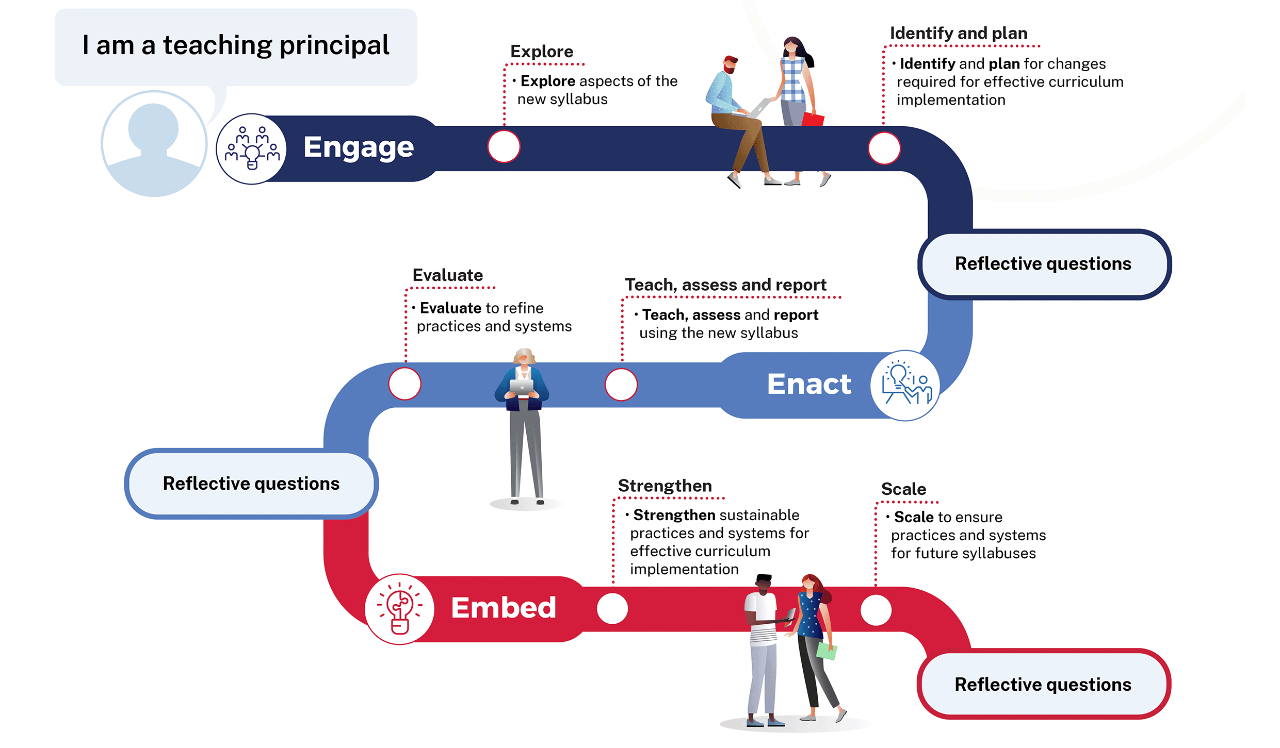- Familiarise yourself and other teachers with the new syllabus by prioritising professional learning from the department’s syllabus-specific Professional learning – curriculum K–12 and NESA online learning hub.
- Identify your professional learning needs to effectively lead change in your school.
- Explore the NSW Curriculum to understand the evidence underpinning the new syllabus.
- Work with the leadership team to lead staff in their understanding of the Phases of curriculum implementation and Leading curriculum K–12.
- Create opportunities for networking with other principals and formal/informal networks of schools (see Curriculum Reform Communities).
Curriculum implementation journey – teaching principal
Guidance for teaching principals implementing a new syllabus. Suggested activities, reflective questions, and useful resources can be used flexibly across a range of schools for each phase of curriculum implementation.


Download the curriculum implementation journey – teaching principal (PDF 1.5 MB) graphic.
Engage
In the engage phase, teaching principals:
- explore aspects of the new syllabus
- identify and plan for changes required for effective curriculum implementation.
Suggested activities
Explore
Identify and plan
- Work collaboratively to identify and meet the diverse learning needs of all students.
- This could include students with disability, high potential and gifted students, Aboriginal students and students who are learning English as an additional language or dialect (see Curriculum planning K–12 professional learning and Universal design for learning).
- Lead the use of School planning for curriculum implementation resources to align with School Excellence Plan (SEP) initiatives.
- Identify school practices to support continuous, school-wide improvement through effective syllabus implementation aligned with the agreed actions in the NSW Plan for public education.
- Review the school budget to ensure adequate resourcing for new syllabus implementation (see Resourcing considerations for teaching principals).
- Allocate time to select and adapt resources to teach the new syllabus (see Planning programming and assessing K–12).
- Collaboratively plan the school approach to assessing and reporting (see Effective assessment practice and NESA assessment advice).
- Use Transition from primary to high school advice to facilitate effective transition processes and strengthen continuity of learning practices.
- To what extent do I and/or my team have a deep understanding of the syllabus and the evidence underpinning the new syllabus?
- What resources are required to commence syllabus implementation to meet curriculum planning and programming, assessing, and reporting requirements?
- To what extent does the implementation plan allocate time for reflection and evaluation?
Enact
In the enact phase, teaching principals:
- teach, assess and report using the new syllabus
- evaluate to refine practices and systems.
Suggested activities
Teach
- Access and apply professional learning to enhance student learning experiences (see Professional learning curriculum – K–12).
- Collaboratively plan and optimise learning for all students (Curriculum planning for every student – advice).
- Consider networking with other schools to collaboratively plan and program, using the department’s resources, to meet the needs of students (see Planning programming and assessing K–12).
- Ensure there is a coherent, inclusive school-wide approach to deepening teacher understanding of cognitive load theory and explicit teaching practice (see Explicit teaching).
- Implement changes to pedagogy and create opportunities to collaboratively plan and evaluate teaching and learning.
- Create opportunities for explaining the curriculum to parents, carers and the community through authentic community engagement in line with agreed school processes.
Assess and report
- Refine processes for assessing and reporting using the new syllabus (see Reporting to parents).
- Consider networking with other schools to collaboratively plan and use formative and summative assessment to show student progress and achievement aligned to new syllabus outcomes (see NESA Assessment advice and Curriculum planning and programming, assessing and reporting to parents K–12 policy.
- Review systems for analysing internal and external student data to gain insights on student progress (see Data analysis resources – guiding advice).
Evaluate
- Evaluate school processes and structures to ensure they support curriculum implementation (see Evaluating curriculum implementation).
- Share processes, practices and initiatives from across other small schools in similar contextual settings to your school.
- Use strategic financial management to maximise resources available to implement the new syllabuses.
- This may include sharing resources across small school networks.
- This may include sharing resources across small school networks.
- Connect with other schools to plan effective learning experiences for the full range of students?
- To what extent are parents and the school community aware of the changes to the curriculum?
- How effective are the processes in place to support changes to assessing and reporting?
- How effective are the processes and structures in place to evaluate the implementation of new curriculum?
Embed
In the embed phase, teaching principals strengthen and scale to ensure sustainable practices and systems.
Suggested activities
Strengthen
- Create a culture of evidence-based teaching and learning for ongoing improvement.
- Access ongoing professional learning to ensure a high expectations culture for student learning (see Principals).
Scale
- Evaluate school processes and structures for whole school monitoring of planning and programming, assessing and reporting (see Evaluative thinking).
- Review implementation data and consider changes to the School Excellence Plan (SEP) to meet system expectations for future syllabus implementation.
- Refine school approach for identifying effective curriculum implementation practice for future syllabuses, see Annual reflection support tool (DOCX 74 KB) (staff only).
- Scale processes, practices and successes from across other small schools in similar contextual settings to your school.
- What has been the impact of curriculum change on student learning?
- To what extent has the implementation of the new syllabus led to improvements in teaching practice?
- What are the enablers and barriers for future curriculum implementation?
Page details
Last modified date
24/10/2025
Business unit contact email
-
Executive director
Megan Kelly
Executive director’s business unit
Teaching Learning&Student Wellbeing
